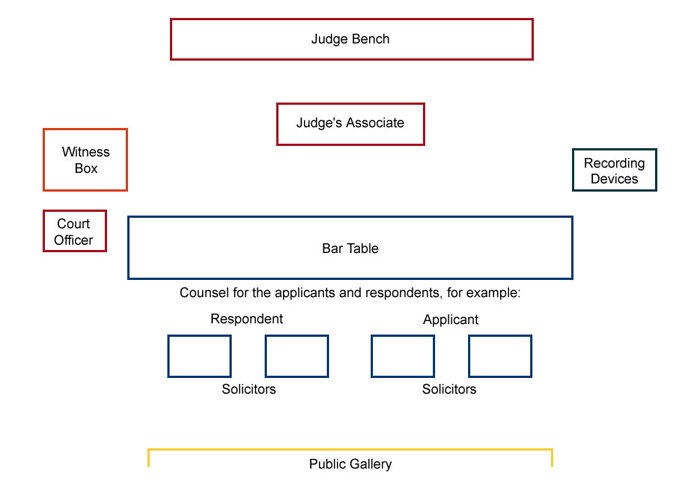Attending Court
- What is the layout of a Court?
- How do I address a Judge or a Judicial Registrar in Court?
- What happens when I go to Court?
- Can I use communication devices in Court?
What is the layout of a Court?

A typical courtroom layout
| Bench: | The Judge/Judicial Registrar sits on the bench facing the Court. |
| Associate Table: | This table is in front of the bench also facing the Court. It is occupied by the Associate to the Judge or a staff member assisting a Judicial Registrar. They sit facing the Court. |
| Bar Table: | The bar table is in front of the bench. It is occupied by the counsel, solicitors or self-represented litigants. |
| Court Officer area: | The Court Officer may either sit at a small table in the courtroom near the Bar Table, or on the Associate's Table next to the Associate. |
| Witness box: | There will be a witness box in the courtroom in such a position so that the witness can be seen by the person sitting on the bench and by those at the bar table who will 'examine' the witness. |
| Transcript area: | Many of the Court's hearings are recorded. There is a space in the courtroom for the person recording the hearing to sit. |
| Public gallery: | All Federal Court hearings are open to the general public and there is seating for that purpose. |
How do I address a Judge or a Judicial Registrar in Court?
You should stand up when you are speaking to the Judge or Judicial Registrar. You should also stand up when the Judge or Judicial Registrar is speaking to you.
| When | Guideline | Example |
|---|---|---|
| How to address the Chief Justice and a Federal Court Judge | ||
| Addressing a Judge in open Court | In Court, parties/legal practitioners refer to the Judge as 'Your Honour'. | 'Yes, your Honour.' |
| How to address a Judicial Registrar | ||
| Addressing a Judicial Registrar in Court, a case management conference or mediation | A Judicial Registrar should be addressed as 'Registrar' unless they advise otherwise | 'Yes, Registrar' |
Further information on how to communicate with the Court.
What happens when I go to Court?
When you enter or leave a courtroom and a Judge or Judicial Registrar is in the courtroom, you should bow your head as you enter or leave.
When you hear your case called in Court you should walk to the Bar Table at the front of the courtroom and tell the Judge or Judicial Registrar your name.
The Judge or Judicial Registrar will usually ask you about the type of claim you are making and after discussion with both parties, may set a timetable for the next steps in the matter such as preparation and filing of evidence and pleadings.
The Judge or Judicial Registrar will also set a date for the next case management hearing. You may wish to contact the solicitor or if they are unrepresented, the other party to discuss a timetable prior to the first case management hearing date. Rule 5.04 of the Rules sets out the types of orders that a Judge may make.
Can I use communication devices in Court?
Please refer to the Court's policy regarding the Use of Communication Devices in a courtroom.









